Candidate List of Substances of Very High Concern for Authorisation-高关注物质
伊维菌素 MSDS
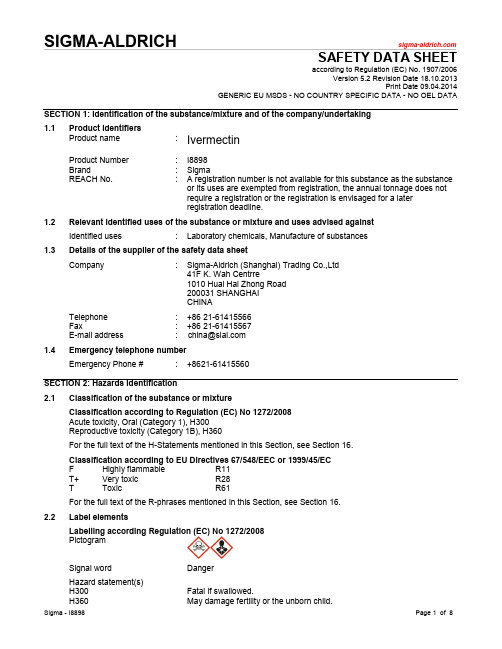
SIGMA-ALDRICH SAFETY DATA SHEETaccording to Regulation (EC) No. 1907/2006Version 5.2 Revision Date 18.10.2013Print Date 09.04.2014GENERIC EU MSDS - NO COUNTRY SPECIFIC DATA - NO OEL DATA SECTION 1: Identification of the substance/mixture and of the company/undertaking1.1 Product identifiersProduct name : IvermectinProduct Number : I8898Brand : SigmaREACH No. : A registration number is not available for this substance as the substanceor its uses are exempted from registration, the annual tonnage does notrequire a registration or the registration is envisaged for a laterregistration deadline.1.2 Relevant identified uses of the substance or mixture and uses advised againstIdentified uses : Laboratory chemicals, Manufacture of substances1.3 Details of the supplier of the safety data sheetCompany : Sigma-Aldrich (Shanghai) Trading Co.,Ltd41F K. Wah Centrre1010 Huai Hai Zhong Road200031 SHANGHAICHINATelephone : +86 21-61415566Fax : +86 21-61415567E-mail address : china@1.4 Emergency telephone numberEmergency Phone # : +8621-61415560SECTION 2: Hazards identification2.1 Classification of the substance or mixtureClassification according to Regulation (EC) No 1272/2008Acute toxicity, Oral (Category 1), H300Reproductive toxicity (Category 1B), H360For the full text of the H-Statements mentioned in this Section, see Section 16.Classification according to EU Directives 67/548/EEC or 1999/45/ECF Highly flammable R11T+ Very toxic R28T Toxic R61For the full text of the R-phrases mentioned in this Section, see Section 16.2.2 Label elementsLabelling according Regulation (EC) No 1272/2008PictogramSignal word DangerHazard statement(s)H300 Fatal if swallowed.H360 May damage fertility or the unborn child.Precautionary statement(s)P201 Obtain special instructions before use.P264 Wash hands thoroughly after handling.P301 + P310 IF SWALLOWED: Immediately call a POISON CENTER or doctor/physician.P308 + P313 IF exposed or concerned: Get medical advice/ attention.noneSupplemental HazardStatementsRestricted to professional users.According to European Directive 67/548/EEC as amended.Hazard symbol(s) T+ Very toxicR-phrase(s)R61 May cause harm to the unborn child.R28 Also very toxic if swallowed.S-phrase(s)S53 Avoid exposure - obtain special instructions before use.S28 After contact with skin, wash immediately with plenty of water.S36/37 Wear suitable protective clothing and gloves.S45 In case of accident or if you feel unwell, seek medical advice immediately(show the label where possible).Restricted to professional users.2.3 Other hazards -noneSECTION 3: Composition/information on ingredients3.2 MixturesChemical characterization : Natural productFor the full text of the H-Statements and R-Phrases mentioned in this Section, see Section 16 SECTION 4: First aid measures4.1 Description of first aid measuresGeneral adviceConsult a physician. Show this safety data sheet to the doctor in attendance.If inhaledIf breathed in, move person into fresh air. If not breathing, give artificial respiration. Consult a physician.In case of skin contactWash off with soap and plenty of water. Take victim immediately to hospital. Consult a physician.In case of eye contactRinse thoroughly with plenty of water for at least 15 minutes and consult a physician.If swallowedNever give anything by mouth to an unconscious person. Rinse mouth with water. Consult a physician. 4.2 Most important symptoms and effects, both acute and delayedThe most important known symptoms and effects are described in the labelling (see section 2.2) and/or in section 114.3 Indication of any immediate medical attention and special treatment neededno data availableSECTION 5: Firefighting measures5.1 Extinguishing mediaSuitable extinguishing mediaUse water spray, alcohol-resistant foam, dry chemical or carbon dioxide.5.2 Special hazards arising from the substance or mixtureCarbon oxides, nitrogen oxides (NOx)5.3 Advice for firefightersWear self contained breathing apparatus for fire fighting if necessary.5.4 Further informationno data availableSECTION 6: Accidental release measures6.1 Personal precautions, protective equipment and emergency proceduresWear respiratory protection. Avoid dust formation. Avoid breathing vapours, mist or gas. Ensureadequate ventilation. Evacuate personnel to safe areas. Avoid breathing dust.For personal protection see section 8.6.2 Environmental precautionsPrevent further leakage or spillage if safe to do so. Do not let product enter drains.6.3 Methods and materials for containment and cleaning upPick up and arrange disposal without creating dust. Sweep up and shovel. Keep in suitable, closedcontainers for disposal.6.4 Reference to other sectionsFor disposal see section 13.SECTION 7: Handling and storage7.1 Precautions for safe handlingAvoid contact with skin and eyes. Avoid formation of dust and aerosols.Avoid exposure - obtain special instructions before use.Provide appropriate exhaust ventilation at places where dust is formed.For precautions see section 2.2.7.2 Conditions for safe storage, including any incompatibilitiesStore in cool place. Keep container tightly closed in a dry and well-ventilated place.Recommended storage temperature: 2 - 8 °C7.3 Specific end use(s)A part from the uses mentioned in section 1.2 no other specific uses are stipulatedSECTION 8: Exposure controls/personal protection8.1 Control parametersComponents with workplace control parameters8.2 Exposure controlsAppropriate engineering controlsAvoid contact with skin, eyes and clothing. Wash hands before breaks and immediately after handling the product.Personal protective equipmentEye/face protectionFace shield and safety glasses Use equipment for eye protection tested and approved underappropriate government standards such as NIOSH (US) or EN 166(EU).Skin protectionHandle with gloves. Gloves must be inspected prior to use. Use proper glove removal technique(without touching glove's outer surface) to avoid skin contact with this product. Dispose ofcontaminated gloves after use in accordance with applicable laws and good laboratory practices.Wash and dry hands.The selected protective gloves have to satisfy the specifications of EU Directive 89/686/EEC andthe standard EN 374 derived from it.Full contactMaterial: Nitrile rubberMinimum layer thickness: 0,11 mmBreak through time: 480 minMaterial tested:Dermatril® (KCL 740 / Aldrich Z677272, Size M)Splash contactMaterial: Nitrile rubberMinimum layer thickness: 0,11 mmBreak through time: 480 minMaterial tested:Dermatril® (KCL 740 / Aldrich Z677272, Size M)data source: KCL GmbH, D-36124 Eichenzell, phone +49 (0)6659 87300, e-mail sales@kcl.de,test method: EN374If used in solution, or mixed with other substances, and under conditions which differ from EN 374,contact the supplier of the CE approved gloves. This recommendation is advisory only and mustbe evaluated by an industrial hygienist and safety officer familiar with the specific situation ofanticipated use by our customers. It should not be construed as offering an approval for anyspecific use scenario.Body ProtectionComplete suit protecting against chemicals, The type of protective equipment must be selectedaccording to the concentration and amount of the dangerous substance at the specific workplace.Respiratory protectionWhere risk assessment shows air-purifying respirators are appropriate use a full-face particlerespirator type N100 (US) or type P3 (EN 143) respirator cartridges as a backup to engineeringcontrols. If the respirator is the sole means of protection, use a full-face supplied air respirator. Userespirators and components tested and approved under appropriate government standards suchas NIOSH (US) or CEN (EU).Control of environmental exposurePrevent further leakage or spillage if safe to do so. Do not let product enter drains.SECTION 9: Physical and chemical properties9.1 Information on basic physical and chemical propertiesa) Appearance Form: solidb) Odour no data availablec) Odour Threshold no data availabled) pH no data availablee) Melting point/freezingno data availablepointno data availablef) Initial boiling point andboiling rangeg) Flash point no data availableh) Evapouration rate no data availablei) Flammability (solid, gas) no data availableno data availablej) Upper/lowerflammability orexplosive limitsk) Vapour pressure no data availablel) Vapour density no data availablem) Relative density no data availablen) Water solubility no data availableno data availableo) Partition coefficient: n-octanol/waterp) Auto-ignitionno data availabletemperatureno data availableq) Decompositiontemperaturer) Viscosity no data availables) Explosive properties no data availablet) Oxidizing properties no data available9.2 Other safety informationno data availableSECTION 10: Stability and reactivity10.1 Reactivityno data available10.2Chemical stabilityStable under recommended storage conditions.10.3 Possibility of hazardous reactionsno data available10.4 Conditions to avoidno data available10.5 Incompatible materialsno data available10.6 Hazardous decomposition productsIn the event of fire: see section 5SECTION 11: Toxicological information11.1Information on toxicological effectsAcute toxicityno data availableSkin corrosion/irritationno data availableSerious eye damage/eye irritationno data availableRespiratory or skin sensitisationno data availableGerm cell mutagenicityno data availableCarcinogenicityIARC: No component of this product present at levels greater than or equal to 0.1% is identified as probable, possible or confirmed human carcinogen by IARC.Reproductive toxicityno data availableSpecific target organ toxicity - single exposureno data availableSpecific target organ toxicity - repeated exposureno data availableAspiration hazardno data availableAdditional InformationRTECS: Not availableTo the best of our knowledge, the chemical, physical, and toxicological properties have not beenthoroughly investigated.Blood - Irregularities - Based on Human Evidence (Formamide)SECTION 12: Ecological information12.1Toxicityno data available12.2Persistence and degradabilityno data available12.3Bioaccumulative potentialno data available12.4 Mobility in soilno data available12.5Results of PBT and vPvB assessmentPBT/vPvB assessment not available as chemical safety assessment not required/not conducted12.6Other adverse effectsno data availableSECTION 13: Disposal considerations13.1 Waste treatment methodsProductOffer surplus and non-recyclable solutions to a licensed disposal company. Dissolve or mix the material with a combustible solvent and burn in a chemical incinerator equipped with an afterburner and scrubber.Contaminated packagingDispose of as unused product.SECTION 14: Transport information14.1 UN numberADR/RID: 2811IMDG: 2811 IATA: 281114.2 UN proper shipping nameADR/RID: TOXIC SOLID, ORGANIC, N.O.S. (Ivermectin)IMDG: TOXIC SOLID, ORGANIC, N.O.S. (Ivermectin)IATA: Toxic solid, organic, n.o.s. (Ivermectin)14.3 Transport hazard class(es)ADR/RID: 6.1IMDG: 6.1 IATA: 6.114.4 Packaging groupADR/RID: II IMDG: II IATA: II14.5 Environmental hazardsADR/RID: no IMDG Marine pollutant: no IATA: no14.6 Special precautions for userno data availableSECTION 15: Regulatory informationThis safety datasheet complies with the requirements of Regulation (EC) No. 1907/2006.15.1Safety, health and environmental regulations/legislation specific for the substance or mixtureAuthorisations and/or restrictions on useFormamide CAS-No.: 75-12-7Candidate List of Substances of Very High Concern for AuthorisationToxic for reproduction (article 57c)15.2Chemical Safety AssessmentFor this product a chemical safety assessment was not carried outSECTION 16: Other informationFull text of H-Statements referred to under sections 2 and 3.Acute Tox.Acute toxicityCarc. CarcinogenicityH300 Fatal if swallowed.H351 Suspected of causing cancer.H360May damage fertility or the unborn child.H360D May damage the unborn child.H373 May cause damage to organs (/$/*_ORG_REP_ORAL/$/) through prolonged orrepeated exposure if swallowed.Repr. Reproductive toxicitySTOT RE Specific target organ toxicity - repeated exposureFull text of R-phrases referred to under sections 2 and 3T ToxicR11 Highly flammable.R28 Very toxic if swallowed.R40 Limited evidence of a carcinogenic effect.T+ Very toxicR48/22 Harmful: danger of serious damage to health by prolonged exposure if swallowed.R61 May cause harm to the unborn child.Further informationCopyright 2013 Sigma-Aldrich Co. LLC. License granted to make unlimited paper copies for internal use only.The above information is believed to be correct but does not purport to be all inclusive and shall be used only as a guide. The information in this document is based on the present state of our knowledge and is applicable to the product with regard to appropriate safety precautions. It does not represent any guarantee of the properties of the product. Sigma-Aldrich Corporation and its Affiliates shall not be held liable for any damage resulting from handling or from contact with the above product. See and/or the reverse side of invoice or packing slip for additional terms and conditions of sale.。
reach197项物质清单

Reach197项物质清单简介REACH(Registration, Evaluation, Authorization and Restriction of Chemicals)是欧盟制定的化学物质管理法规。
其目的是保护人类和环境免受化学物质的危害,同时促进欧洲化学工业的创新和竞争力。
REACH法规要求对在欧洲市场上生产或进口的化学物质进行注册、评估和授权,并对某些危险化学物质实施限制。
REACH法规自2007年生效以来,对化学行业和相关企业都带来了很大的挑战和变革。
REACH197项物质清单是根据REACH法规编制的清单,包含了197种被认为对人类健康和环境有潜在危害的化学物质。
这些物质被欧盟列为“非常关注物质”(Substances of Very High Concern, SVHC),需要特别关注和管理。
本文将逐一介绍REACH197项物质清单中的化学物质,并对其危害和管理措施进行概述。
REACH197项物质清单以下是REACH197项物质清单中的一部分化学物质:1.1-氧二环己基-2-戊基甲基异噻唑离子(OTNT):主要用于制造塑料和橡胶制品。
被认为是一种可疑的致癌物。
2.苯并[a]芘:是一种强烈的致癌物,主要存在于烟草烟雾中。
它还可以通过工业汽车排放物和工业废水进入环境。
3.叔丁基氢氧化铅:被广泛使用的一种铅添加剂,在汽车燃料中添加以提高燃烧效率。
然而,它已被证实对人体和环境有毒。
4.苯并[a]芴:是一种多环芳烃化合物,主要从燃烧煤和石油产生。
它被认为是一种潜在的致癌物和致畸物。
以上只是REACH197项物质清单中的一小部分示例。
在清单中还包括其他有毒物质、致突变物质、致畸物等。
管理措施对于被列为REACH197项物质清单的化学物质,欧盟采取了一系列的管理措施。
其中包括:•注册:生产或进口这些物质的公司需要向欧洲化学品管理局(European Chemicals Agency, ECHA)进行注册,提交相关的信息,包括物质的性质、用途和潜在危害等。
厂商承诺REACH环保保证书(样板)

我司要求供应商交货在下列范围内做出环保承诺:REACH Certificate of ConformanceREACH 合格保证书MANUFACTURER hereby represents and warrants that the part numbers listed below suppliedare in compliance with European Union’s Directive relating to EU REGULATION (EC) No.1907/2006 (REACH Directives), on the restriction of any Substances of Very High Concern(SVHC) (Article 57), which is included in the Candidate List developed by the EuropeanChemical Agency (ECHA). 尊敬的厂商:下面所要代表和认证的清单是依据欧盟REACH相关EU REGULATION (EC) No. 1907/2006条款要求执行的(涵盖限制环保物质的条款多达57条),这些有关补充的环保物质的条款,依据发展的需要,我们将严格按照此要求进行生产管制。
The REACH legislation covers the restriction of the follow candidate list of Substances of VeryHigh Concern (Updated on 2011/6/20). The maximum permitted concentrations are 0.1% (w/w)measured at weight by weight (also which and amount). 关于REACH立法,已经覆盖了高度关注的以下所有在表格内的物质,并于2011年6月20曰生效执行,任何SVHC物质许可通关的要求最高含量已按照重量比要求测量,结果不得高于0.1%(w/w)。
svhc里对bpa的要求

svhc里对bpa的要求SVHC要求中的BPABPA,即双酚A(Bisphenol A),是一种常用的化学物质,用于制造塑料和树脂,如食品包装、瓶子、玩具等。
不过,它也被发现具有潜在的健康危害,因此被欧盟列为“极其关注物质”(Substances of Very High Concern, SVHC)之一。
SVHC是欧盟REACH法规中规定的一类化学物质,由于它们具有潜在的危害,因此需要进行严格的管控和监测。
在这些物质中,BPA被列为了其中之一。
在欧盟化学品管理局(ECHA)的官方网站上,可以查看到BPA的详细信息和相关要求。
BPA被列为SVHC的原因是因为它可以干扰内分泌系统,影响人类健康。
BPA的化学结构类似于雌激素,因此可以模拟雌激素的作用,干扰人类内分泌系统的正常功能,对胎儿和儿童的发育产生不良影响。
此外,BPA还被怀疑与乳腺癌、子宫内膜癌、前列腺癌等多种癌症有关。
为了保护公众健康,欧盟对BPA的使用做出了一系列要求。
首先,BPA被列入了欧盟候选清单(Candidate List),企业必须在候选清单上的物质达到0.1%的含量限制时,向消费者提供有关该物质的信息。
此外,欧盟还规定了BPA的限制条件,包括:1.在婴儿奶瓶和婴儿奶嘴中禁止使用BPA;2.对BPA在食品接触材料中的使用做出限制,最高容许量为0.05毫克/千克;3.对BPA在烟草制品中的使用做出限制,最高容许量为10毫克/千克。
欧盟还要求企业对使用BPA的产品进行评估,确保其使用安全。
如果BPA的使用被认为是不安全的,欧盟将采取相应的措施,包括禁止或限制其使用。
BPA是一种被欧盟列为SVHC的化学物质,其使用受到严格的限制和管控。
为了保护公众健康,欧盟对BPA的使用做出了一系列要求,涉及到婴儿奶瓶、食品接触材料、烟草制品等多个领域。
企业需要对使用BPA的产品进行评估,确保其使用安全。
通过这些措施,欧盟将继续保护公众健康,并致力于减少化学物质对环境的影响。
最新最全的SVHC清单
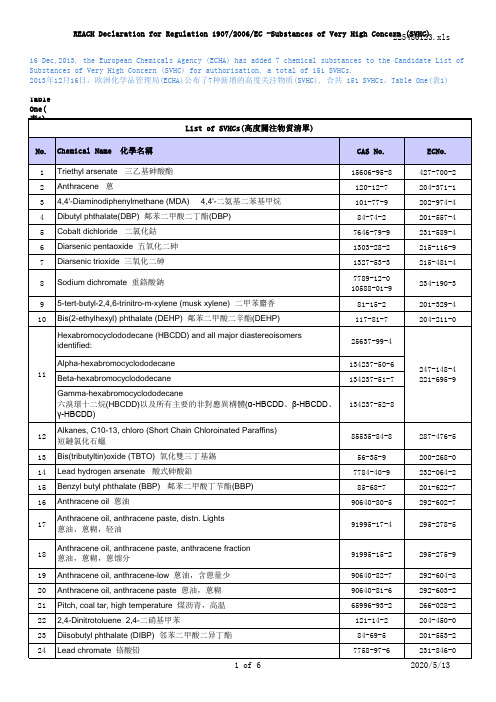
Lead sulfochromate yellow (C.I. Pigment Yellow 34) 铬橙、颜料黄34 tris(2chloroethyl)phosphate (TCEP) 三(2-氯乙基)磷酸酯 Acrylamide 丙烯酰胺 Trichloroethylene 三氯乙烯 Boric acid 硼酸
11
Beta-hexabromocyclododecane Gamma-hexabromocyclododecane 六溴環十二烷(HBCDD)以及所有主要的非對應異構體(α-HBCDD、β-HBCDD、γ -HBCDD)
12 13 14 15 16 17
Alkanes, C10-13, chloro (Short Chain Chloroinated Paraffins) 短鏈氯化石蠟 Bis(tributyltin)oxide (TBTO) 氧化雙三丁基錫 Lead hydrogen arsenate 酸式砷酸鉛 Benzyl butyl phthalate (BBP) 鄰苯二甲酸丁芐酯(BBP) Anthracene oil 蒽油 Anthracene oil, anthracene paste, distn. Lights 蒽油,蒽糊,轻油 Anthracene oil, anthracene paste, anthracene fraction 蒽油,蒽糊,蒽馏分 Anthracene oil, anthracene-low 蒽油,含蒽量少 Anthracene oil, anthracene paste 蒽油,蒽糊 Pitch, coal tar, high temperature 煤沥青,高温 2,4-Dinitrotoluene 2,4-二硝基甲苯 Diisobutyl phthalate (DIBP) 邻苯二甲酸二异丁酯 Lead chromate 铬酸铅 Lead chromate molybdate sulfate red (C.I. Pigment Red 104) 1 of 6 钼铬红、钼红
15 SvHC_candidate_list
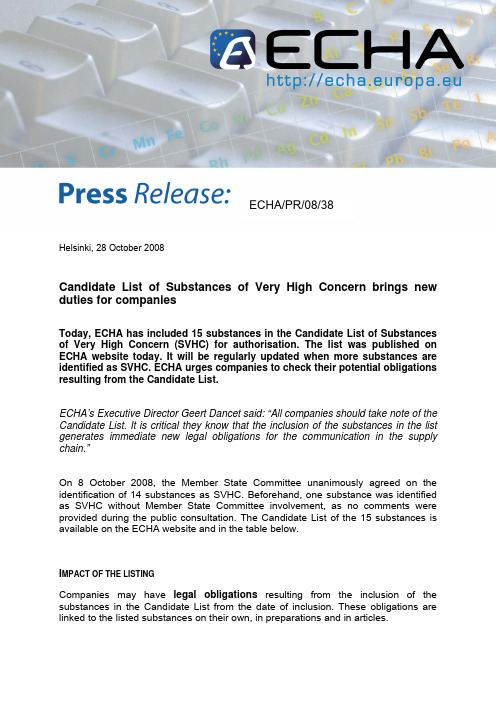
ECHA/PR/08/38Helsinki, 28 October 2008Candidate List of Substances of Very High Concern brings new duties for companiesToday, ECHA has included 15 substances in the Candidate List of Substances of Very High Concern (SVHC) for authorisation. The list was published on ECHA website today. It will be regularly updated when more substances are identified as SVHC. ECHA urges companies to check their potential obligations resulting from the Candidate List.ECHA’s Executive Director Geert Dancet said: “All companies should take note of the Candidate List. It is critical they know that the inclusion of the substances in the list generates immediate new legal obligations for the communication in the supply chain.”On 8 October 2008, the Member State Committee unanimously agreed on the identification of 14 substances as SVHC. Beforehand, one substance was identified as SVHC without Member State Committee involvement, as no comments were provided during the public consultation. The Candidate List of the 15 substances is available on the ECHA website and in the table below.I MPACT OF THE LISTINGCompanies may have legal obligations resulting from the inclusion of the substances in the Candidate List from the date of inclusion. These obligations are linked to the listed substances on their own, in preparations and in articles.O BLIGATIONS:A RTICLES•From 28 October 2008, EU & EEA suppliers of articles which contain substances on the Candidate List in a concentration above 0.1% (w/w) must provide sufficient information, available to them,to their customers and on request to consumers within 45 days of the receipt of this request. This information must ensure safe use of the article and, as a minimum, include the name of the substance.•From 1 December 2011, EU and EEA producers or importers of articles have to notify ECHA when their article contains a substance on the Candidate List. This obligation applies if the substance is present above 0.1% (w/w) and its quantities in the produced/imported articles are above 1 tonne in total per year per company.O BLIGATIONS:S UBSTANCES•From 28 October 2008, EU & EEA suppliers of a substance have to provide a safety data sheet to their customers when the substance is on the Candidate List.O BLIGATIONS:P REPARATIONS•From 28 October 2008, EU and EEA suppliers of a preparation not classified as dangerous according to Directive 1999/45/EC have to provide the recipients, at their request, with a safety data sheet if the preparation contains at least one substance on the Candidate List and its individual concentration is at least 0.1% (w/w) for non gaseous preparations and at least 0.2% by volume for gaseous preparations.Further InformationThe Candidate list pages on the ECHA website provide an up-to-date version of the list as well as background information on it and related obligations. The pages can be accessed at: http://echa.europa.eu/chem_data/candidate_list_en.aspPress questions in relation to this press release should be sent to: press@echa.europa.euAnnex 1: The Candidate ListSubstance name EC number(CAS Number)Basis forIdentification as aSVHCAnthracene 204-371-1 Persistent,bioaccumulative andtoxic4,4'- Diaminodiphenylmethane 202-974-4 Carcinogen, cat. 2 Dibutyl phthalate 201-557-4 Toxic for reproduction,cat. 2Cobalt dichloride 231-589-4 Carcinogen, cat. 2 Diarsenic pentaoxide 215-116-9 Carcinogen, cat.1 Diarsenic trioxide 215-481-4 Carcinogen,cat.1Sodium dichromate 234-190-3(7789-12-010588-01-9) Carcinogen, cat. 2; Mutagen, cat. 2 Toxic for reproduction, cat. 25-tert-butyl-2,4,6-trinitro-m-xylene (musk xylene) 201-329-4 Very persistent and verybioaccumulativeBis (2-ethyl(hexyl)phthalate) (DEHP) 204-211-0 Toxic for reproduction,cat.2Hexabromocyclododecane (HBCDD) and all major diastereoisomers identified (α – HBCDD, β-HBCDD, γ-HBCDD) 247-148-4 and 221-695-9(134237-50-6, 134237-51-7,134237-52-8)Persistent,bioaccumulative andtoxicAlkanes, C10-13, chloro (Short Chain Chlorinated Paraffins) 287-476-5 Persistent,bioaccumulative andtoxicVery persistent and verybioaccumulativeBis(tributyltin)oxide 200-268-0 Persistent,bioaccumulative andtoxicLead hydrogen arsenate 232-064-2 Carcinogen, cat. 1Toxic for reproductioncat. 1Benzyl butyl phthalate 201-622-7 Toxic for reproduction,cat. 2Triethyl arsenate 427-700-2 Carcinogen, cat. 1。
最新REACH 151项--REACH-SVHC151项清单中英文

REACH 151项SVHC清单155 kinds of substances in the SVHC list2013年12月16日,欧盟化学品管理局(ECHA)已正式将7种物质纳入需授权高度关注物质候选清单(SVHC清单),这是REACH法规实施以后公布的第十份SVHC 清单。
目前,SVHC清单中共有151种物质。
December 16, 2013, the European Chemicals Agency (ECHA) had added 7 chemical substances to the Candidate List of Substances of Very High Concern (SVHC) for Authorization, this is the 10nd edition of SVHC list since the enforcement of REACH regulation. Currently, a total of 151 kinds of substances were in the SVHC list.第一批SVHC清单(2008年10月28日公布,共15种)第二批SVHC清单(2010年1月13日公布,共13种)第三批SVHC清单(2010年6月18日公布,共8种)第四批SVHC清单(2010年12月15日公布,共8种)第五批SVHC清单(2011年6月20日公布,共7种)第六批SVHC清单(2011年12月19日公布,共20种)第七批SVHC清单(2012年6月18日公布,共13种)第八批SVHC清单(2012年12月19日公布,共54种)第九批SVHC清单(2013年6月20日公布,共6种)第十批SVHC清单(2013年12月16日公布,共7种)。
IPC关于焊接的常用标准210-88-422-41-101000
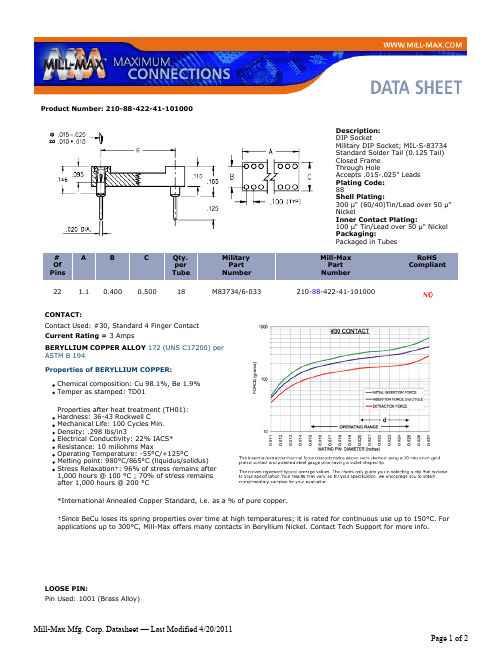
INSULATOR INFORMATION: PCT Polyester, (Thermx CG933, black) High Temperature Properties of PCT Polyester: Brand: Thermx Grade: CG-933 Rated voltage: 100 VRMS/150 VDC Insulation resistance: 10,000 Megaohms min. Material Heat Deflection Temp (per ASTM D 648): 529°F (276°C) @ 66 psi Dielectric strength: 1000 VRMS min. (700 VRMS min. for series 117 Shrink DIP) Note: Materials above 446°F (230°C) are considered suitable for "eutectic" reflow soldering, above 500°F (260°C) for "lead-free" reflow soldering. Certificate of Compliance: This is to Certify that the product described above is manufactured to Mill-Max quality standards in accordance with all applicable specifications and drawing. Mill-Max certifies this product to be free from defects of materials and workmanship. This Certificate of Compliance covers the following requirements: Dimensional (all features verified to be within tolerances described on the applicable drawing). Raw Material (materials and properties verified to be as described on the applicable drawing). Plating (platings as required, thickness verified, and performance including solderability per mil-standard). Performance (insertion extraction or other force requirements as described on the applicable drawing).
出口蓄电池不含有害物质声明
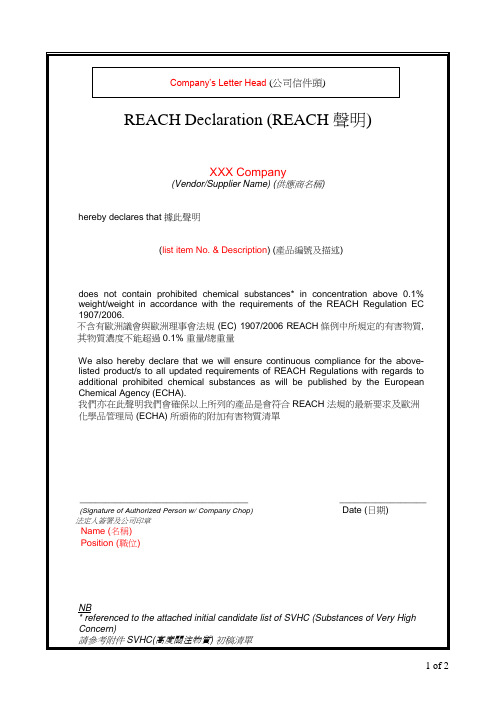
Name(名稱)
Position(職位)
NB
* referenced to the attached initial candidate list of SVHC (Substances of Very High Concern)
請參考附件SVHC’s Letter Head(公司信件頭)
REACHDeclaration(REACH聲明)
XXX Company
(Vendor/Supplier Name)(供應商名稱)
hereby declares that據此聲明
(list item No. & Description)(產品編號及描述)
我們亦在此聲明我們會確保以上所列的產品是會符合REACH法規的最新要求及歐洲化學品管理局(ECHA)所頒佈的附加有害物質清單
__________________________________________________
(Signature of Authorized Person w/ Company Chop)Date(日期)
不含有歐洲議會與歐洲理事會法規(EC) 1907/2006 REACH條例中所規定的有害物質,其物質濃度不能超過0.1%重量/總重量
We also hereby declare that we will ensure continuous compliance for the above-listed product/s to all updated requirements of REACH Regulations with regards to additional prohibited chemical substances as will be published by the European Chemical Agency (ECHA).
最全收录209项EU REACH SVHC(高度关注物质清单)

No.Substance name CAS No.EC No.Basis for identification as a SVHC 1Triethyl arsenate 15606-95-8427-700-2Carcinogenic 2Anthracene 120-12-7204-371-1PBT 34,4’-Diaminodiphenylmethane (MDA)101-77-9202-974-4Carcinogenic 4Dibutyl phthalate (DBP)84-74-2201-557-4Toxic for reproduction; Endocrine disrupting properties 5Cobalt dichloride 7646-79-9231-589-4Carcinogenic 6Diarsenic pentaoxide 1303-28-2215-116-9Carcinogenic 7Diarsenic trioxide 1327-53-3215-481-4Carcinogenic 8Sodium dichromate 7789-12-0234-190-3Carcinogenic ; M utagenic; T oxic for reproduction 10588-01-995-tert-butyl-2,4,6-trinitro-m-xylene (musk xylene)81-15-2201-329-4vPvB 10Bis (2-ethylhexyl) phthalate (DEHP)117-81-7204-211-0Toxic for reproduction; Endocrine disrupting properties 11Hexabromocyclododecane (HBCDD) and all major diastereoisomers identified:3194-55-6247-148-4PBT 25637-99-4221-695-9a - HBCDD 134237-50-6b - HBCDD 134237-51-7g - HBCDD 134237-52-812Alkanes, C10-13, chloro(Short Chain Chlorinated Paraffins) (SCCP)85535-84-8287-476-5PBT, vPvB 13Bis(tributyltin)oxide (TBTO)56-35-9200-268-0PBT 14Lead hydrogen arsenate 7784-40-9232-064-2Carcinogenic; T oxic for reproduction 15Benzyl butyl phthalate (BBP)85-68-7201-622-7Toxic for reproduction; Endocrine disrupting properties 162,4-Dinitrotoluene 121-14-2204-450-0Carcinogenic 17Anthracene oil 90640-80-5292-602-7Carcinogenic, P BT, vPvB 18Anthracene oil, anthracene paste, distn. Lights 91995-17-4295-278-5Carcinogenic; M utagenic, P BT, vPvB 19Anthracene oil, anthracene paste, anthracene fraction 91995-15-2295-275-9Carcinogenic; M utagenic, P BT, vPvB 20Anthracene oil, anthracene-low 90640-82-7292-604-8Carcinogenic; M utagenic, P BT, vPvB 21Anthracene oil, anthracene paste 90640-81-6292-603-2Carcinogenic; M utagenic, P BT, vPvB 22Diisobutyl phthalate (DIBP)84-69-5201-553-2Toxic for reproductionic; Endocrine disrupting properties 23Aluminosilicate, Refractory Ceramic Fibres 650-017-00-8Carcinogenic 24Zirconia Aluminosilicate, Refractory Ceramic Fibres 650-017-00-8Carcinogenic 25Lead chromate 7758-97-6231-846-0Carcinogenic; T oxic for reproduction 26Lead chromate molybdate sulfate red (C.I. Pigment Red 104)12656-85-8235-759-9Carcinogenic; T oxic for reproduction 27Lead sulfochromate yellow (C.I. Pigment Yellow 34)1344-37-2215-693-7Carcinogenic; T oxic for reproduction 28Tris(2-chloroethyl) phosphate 115-96-8204-118-5Toxic for reproduction 29Coal tar pitch, high temperature 65996-93-2266-028-2Carcinogenic, P BT, vPvB 30Acrylamide 79-06-1201-173-7Carcinogenic; M utagenic 31Trichloroethylene 79-01-6201-167-4Carcinogenic 32Boric acid 10043-35-3233-139-2Toxic for reproduction 11113-50-1234-343-433Disodium tetraborate, anhydrous 1330-43-4215-540-4Toxic for reproduction 12179-04-31303-96-434Tetraboron disodium heptaoxide, hydrate 12267-73-1235-541-3Toxic for reproduction 35Sodium chromate 7775-11-3231-889-5Carcinogenic; M utagenic; T oxic for reproduction 36Potassium chromate 7789-00-6232-140-5Carcinogenic; M utagenic 37Ammonium dichromate 7789-09-5232-143-1Carcinogenic; M utagenic; T oxic for reproduction 38Potassium dichromate 7778-50-9231-906-6Carcinogenic; M utagenic; T oxic for reproduction 39Cobalt(II) sulphate 10124-43-3233-334-2Carcinogenic; T oxic for reproduction 40Cobalt(II) dinitrate 10141-05-6233-402-1Carcinogenic; T oxic for reproduction 41Cobalt(II) carbonate 513-79-1208-169-4Carcinogenic; T oxic for reproduction 42Cobalt(II) diacetate 71-48-7200-755-8Carcinogenic; T oxic for reproduction 432-Methoxyethanol 109-86-4203-713-7Toxic for reproduction 442-Ethoxyethanol 110-80-5203-804-1Toxic for reproduction 45Chromium trioxide 1333-82-0215-607-8Carcinogenic; M utagenic 46Acid generated from chromium trioxide and their oligomers:Carcinogenic Chromic acid 7738-94-5231-801-5Dichromic acid 13530-68-2236-881-5Oligomers of chromic acid and dichromic acid-472-Ethoxyethyl acetate 111-15-9203-839-2Toxic for reproduction 48Strontium Chromate 7789-06-2232-142-6Carcinogenic 491,2-benzenedicarboxylic acid, di-C7-11 branched alkyl ester and linear alkyl ester (DHNUP)68515-42-4271-084-6Toxic for reproduction 50Hydrazine 302-01-2206-114-9Carcinogenic 511-Methyl-2-pyrrolidone 872-50-4212-828-1Toxic for reproduction 521,2,3-trichloropropane 96-18-4202-486-1Toxic for reproduction 531,2-benzenedicarboxylic acid, di-C6-8-branched alkyl ester, C7-rich (DIHP)71888-89-6276-158-1Toxic for reproduction 54Dichromium tris(chromate)24613-89-6246-356-2Carcinogenic 55Potassium hydroxyoctaoxodizincatedi-chromate 11103-86-9234-329-8Carcinogenic 56Pentazinc chromate octahydroxide 49663-84-5256-418-0Carcinogenic 57Formaldehyde, oligomeric reaction products with aniline (technical MDA)25214-70-4500-036-1Carcinogenic 58Bis(2-methoxyethyl) phthalate 117-82-8204-212-6Toxic for reproduction 592-Methoxyaniline; o-Anisidine 90-04-0201-963-1Carcinogenic 604-(1,1,3,3-tetramethylbutyl)phenol, (4-tert-Octylphenol)140-66-9205-426-2Equivalent level of concern 611,2-Dichloroethane 107-06-2203-458-1Carcinogenic 62Bis(2-methoxyethyl) ether 111-96-6203-924-4Toxic for reproduction 63Arsenic acid 7778-39-4231-901-9Carcinogenic 64Calcium arsenate 7778-44-1231-904-5Carcinogenic 65Trilead diarsenate 3687-31-8222-979-5Carcinogenic, T oxic for reproduction 66N,N-dimethylacetamide (DMAC)127-19-5204-826-4Toxic for reproduction 672,2’-dichloro-4,4’-methylenedianiline (MOCA)101-14-4202-918-9Carcinogenic 68Phenolphthalein 77-09-8201-004-7Carcinogenic 69Lead azide, Lead diazide 13424-46-9236-542-1Toxic for reproduction 70Lead styphnate 15245-44-0239-290-0Toxic for reproduction 71Lead dipicrate 6477-64-1229-335-2Toxic for reproduction 721,2-bis(2-methoxyethoxy)ethane(TEGDME; triglyme)112-49-2203-977-3Toxic for reproduction 731,2-dimethoxyethane; ethylene glycol dimethyl ether (EGDME)110-71-4203-794-9Toxic for reproduction 74Diboron trioxide 1303-86-2215-125-8Toxic for reproduction 75Formamide 75-12-7200-842-0Toxic for reproduction 76Lead(II) bis(methanesulfonate)17570-76-2401-750-5Toxic for reproduction 77TGIC (1,3,5-tris(oxiranylmethyl)-1,3,5-triazine-2,4,6(1H,3H,5H)-trione)2451-62-9219-514-3Mutagenic 78β-TGIC (1,3,5-tris[(2S and 2R)-2,3-epoxypropyl]-1,3,5-triazine-2,4,6-(1H,3H,5H)-trione)59653-74-6423-400-0Mutagenic 794,4'-bis(dimethylamino)benzophenone (Michler's ketone)90-94-8202-027-5Carcinogenic 80N,N,N',N'-tetramethyl-4,4'-methylenedianiline (Michler's base)101-61-1202-959-2Carcinogenic 81[4-[4,4'-bis(dimethylamino) benzhydrylidene]cyclohexa-2,5-dien-1-ylidene]dimethylammoniumchloride(C.I. Basic Violet 3)548-62-9208-953-6Carcinogenic 82[4-[[4-anilino-1-naphthyl][4-(dimethylamino) phenyl]methylene]cyclohexa-2,5-dien-1-ylidene]dimethylammonium chloride(C.I. Basic Blue 26)2580-56-5219-943-6Carcinogenic 83α,α-Bis[4-(dimethylamino)phenyl]-4 (phenylamino)naphthalene-1-methanol(C.I. Solvent Blue 4)6786-83-0229-851-8Carcinogenic 844,4'-bis(dimethylamino)-4''-(methylamino)trityl alcohol 561-41-1209-218-2Carcinogenic 85Bis(pentabromophenyl) ether (DecaBDE) 1163-19-5214-604-9Persistent, bioaccumulative and toxic; very persistent and very bioaccumulative 86N,N-dimethylformamide; dimethyl formamide 68-12-2200-679-5Toxic for reproduction 87Methoxy acetic acid 625-45-6210-894-6Toxic for reproduction ; equivalent level of concern 88Dibutyltin dichloride (DBT)683-18-1211-670-0Toxic for reproduction 891,2-Diethoxyethane 629-14-1211-076-1Toxic for reproduction 90Hexahydro-2-benzofuran-1,3-dione (HHPA), cis-cyclohexane-1,2-dicarboxylic anhydride, trans-cyclohexane-1,2-dicarboxylic anhydride 85-42-7201-604-9Equivalent level of concern 13149-00-3236-086-314166-21-3238-009-991Hexahydromethylphathalic anhydride, Hexahydro-4-methylphathalic anhydride, Hexahydro-1-methylphathalic anhydride, Hexahydro-3-methylphathalic anhydride 25550-51-0247-094-1Equivalent level of concern 19438-60-9243-072-048122-14-1256-356-457110-29-9260-566-1924-Nonylphenol, branched and linear - substances with a linear and/or branched alkyl chain with acarbon number of 9 covalently bound in position 4 to phenol, covering also UVCB- and well-defined substances which include any of the individual isomers or a combination thereof-Equivalent level of concern 93Heptacosafluorotetradecanoic acid 376-06-7206-803-4Very persistent and very bioaccumulative 941,2-Benzenedicarboxylic acid, dipentylester, branched and linear 84777-06-0284-032-2Toxic for reproduction 95Henicosafluoroundecanoic acid 2058-94-8218-165-4Very persistent and very bioaccumulative 96N-pentyl-isopentylphtalate (iPnPP)776297-69-9-Toxic for reproduction 97Pentacosafluorotridecanoic acid 72629-94-8276-745-2Very persistent and very bioaccumulative 984-(1,1,3,3-tetramethylbutyl)phenol, ethoxylated - covering well-defined substances and UVCBsubstances, polymers and homologues-Equivalent level of concern 99Tricosafluorododecanoic acid 307-55-1206-203-2Very persistent and very bioaccumulative 100Lead bis(tetrafluoroborate)13814-96-5237-486-0Toxic for reproduction 101Lead tetroxide (orange lead)1314-41-6215-235-6Toxic for reproduction 102Diethyl sulphate 64-67-5200-589-6Carcinogenic; Mutagenic 103Dinoseb 88-85-7201-861-7Toxic for reproduction 104Lead Titanium Zirconium Oxide 12626-81-2235-727-4Toxic for reproduction 105Acetic acid, lead salt, basic 51404-69-4257-175-3Toxic for reproduction 106Furan 110-00-9203-727-3Carcinogenic 107N-methylacetamide 79-16-3201-182-6Toxic for reproduction 108o-Toluidine; 2-Aminotoluene 95-53-4202-429-0Carcinogenic 1093-ethyl-2-methyl-2-(3-methylbutyl)-1,3-oxazolidine 143860-04-2421-150-7Toxic for reproduction 1104,4'-oxydianiline and its salts 101-80-4202-977-0Carcinogenic; Mutagenic 111[Phthalato(2-)]dioxotrilead (Dibasic lead phthalate)69011-06-9273-688-5Toxic for reproduction 112Lead titanium trioxide 12060-00-3235-038-9Toxic for reproduction 113Lead oxide sulphate 12036-76-9234-853-7Toxic for reproduction 114Lead dinitrate 10099-74-8233-245-9Toxic for reproductionCandidate List of Substances of Very High Concern for authorization published by European Chemicals Agency (ECHA) Regarding Regulation (EC) No. 1907/2006 concerning REACH- Updated in Jun.20201154-Aminoazobenzene; 4-Phenylazoaniline60-09-3200-453-6Carcinogenic116Lead cyanamidate20837-86-9244-073-9Toxic for reproduction117Tetralead trioxide sulphate12202-17-4235-380-9Toxic for reproduction1184-methyl-m-phenylenediamine (2,4-toluene-diamine)95-80-7202-453-1Carcinogenic119Pyrochlore, antimony lead yellow8012-00-8232-382-1Toxic for reproduction120Trilead bis(carbonate)dihydroxide (basic lead carbonate)1319-46-6215-290-6Toxic for reproduction121Dimethyl sulphate77-78-1201-058-1Carcinogenic122Dioxobis(stearato)trilead12578-12-0235-702-8Toxic for reproduction123Silicic acid, barium salt, lead-doped68784-75-8272-271-5Toxic for reproduction124Biphenyl-4-ylamine92-67-1202-177-1Carcinogenic125Lead oxide (lead monoxide)1317-36-8215-267-0Toxic for reproduction126Pentalead tetraoxide sulphate12065-90-6235-067-7Toxic for reproduction127Propylene oxide; 1,2-epoxypropane; methyloxirane75-56-9200-879-2Carcinogenic; Mutagenic128Silicic acid, lead salt11120-22-2234-363-3Toxic for reproduction129Trilead dioxide phosphonate12141-20-7235-252-2Toxic for reproduction130o-aminoazotoluene97-56-3202-591-2Carcinogenic1311-bromopropane106-94-5203-445-0Toxic for reproduction1326-methoxy-m-toluidine (p-cresidine)120-71-8204-419-1Carcinogenic1334,4'-methylenedi-o-toluidine838-88-0212-658-8Carcinogenic134Tetraethyllead78-00-2201-075-4Toxic for reproduction135Sulfurous acid, lead salt, dibasic62229-08-7263-467-1Toxic for reproduction136Fatty acids, C16-18, lead salts91031-62-8292-966-7Toxic for reproduction137Diisopentylphthalate 605-50-5210-088-4Toxic for reproduction138Diazene-1,2-dicarboxamide (C,C'-azodi(formamide)) 123-77-3204-650-8Equivalent level of concern139Cadmium7440-43-9231-152-8Carcinogenic; Equivalent level of concern 140Cadmium oxide1306-19-0215-146-2Carcinogenic; Equivalent level of concern 141Dipentyl phthalate (DPP) 131-18-0205-017-9Toxic for reproduction1424-Nonylphenol, branched and linear, ethoxylated -Equivalent level of concern143Ammonium pentadecafluorooctanoate (APFO) 3825-26-1223-320-4Toxic for reproduction; PBT144Pentadecafluorooctanoic acid (PFOA) 335-67-1206-397-9Toxic for reproduction; PBT145Cadmium sulphide1306-23-6215-147-8Carcinogenic; Equivalent level of concern 146Dihexyl phthalate (DHP)84-75-3201-559-5Toxic for reproduction147Disodium 3,3'-[[1,1'-biphenyl]-4,4'-diylbis(azo)]bis(4-aminonaphthalene-1-sulphonate) (C.I. DirectRed 28)573-58-0209-358-4Carcinogenic148Disodium 4-amino-3-[[4'-[(2,4-diaminophenyl)azo][1,1'-biphenyl]-4-yl]azo] -5-hydroxy-6-(phenylazo)naphthalene-2,7-disulphonate (C.I. Direct Black 38)1937-37-7217-710-3Carcinogenic149Imidazolidine-2-thione (2-imidazoline-2-thiol)96-45-7202-506-9Toxic for reproduction150Lead di(acetate)301-04-2206-104-4Toxic for reproduction151Trixylyl phosphate25155-23-1246-677-8Toxic for reproduction152Cadmium chloride 10108-64-2 233-296-7 Carcinogenic; Mutagenic; Toxic for reproduction; Equivalent level of concern having probable serious effects to human health 1531,2-Benzenedicarboxylic acid, dihexyl ester, branched and linear68515-50-4 271-093-5 Toxic for reproduction154Sodium peroxometaborate 7632-04-4231-556-4 Toxic for reproduction155Sodium perborate; perboric acid, sodium salt239-172-9Toxic for reproduction234-390-0156Cadmium fluoride7790-79-6232-222-0Carcinogenic; Mutagenic; Toxic for Reproduction; Equivalent level of concern having probable serious effects to human health 157Cadmium sulphate10124-36-4233-331-6Carcinogenic; Mutagenic; Toxic for Reproduction; Equivalent level of concern having probable serious effects to human health31119-53-61582-benzotriazol-2-yl-4,6-di-tert-butylphenol (UV-320)3846-71-7223-346-6PBT; vPvB1592-(2H-benzotriazol-2-yl)-4,6-ditertpentylphenol (UV-328)25973-55-1247-384-8PBT; vPvB1602-ethylhexyl 10-ethyl-4,4-dioctyl-7-oxo-8-oxa-3,5-dithia-4-stannatetradecanoate (DOTE)15571-58-1239-622-4Toxic for Reproduction161Reaction mass of 2-ethylhexyl 10-ethyl-4,4-dioctyl-7-oxo-8-oxa-3,5-dithia-4-stannatetradecanoateand 2-ethylhexyl 10-ethyl-4-[[2-[(2-ethylhexyl)oxy]-2-oxoethyl]thio]-4-octyl-7-oxo-8-oxa-3,5-dithia-4-stannatetradecanoate (reaction mass of DOTE and MOTE)-Toxic for Reproduction1621,2-benzenedicarboxylic acid, di-C6-10-alkyl esters; 1,2-benzenedicarboxylic acid, mixed decyl andhexyl and octyl diesters with ≥ 0.3% of dihexyl phthalate (EC No. 201-559-5)68515-51-5271-094-0Toxic for reproduction68648-93-1272-013-11635-sec-butyl-2-(2,4-dimethylcyclohex-3-en-1-yl)-5-methyl-1,3-dioxane [1], 5-sec-butyl-2-(4,6-dimethylcyclohex-3-en-1-yl)-5-methyl-1,3-dioxane [2] [covering any of the individual isomers of[1] and [2] or any combination thereof]-Very persistent and very bioaccumulative1641,3-propanesultone1120-71-4214-317-9Carcinogenic 1652,4-di-tert-butyl-6-(5-chlorobenzotriazol-2-yl)phenol (UV-327)3864-99-1223-383-8vPvB1662-(2H-benzotriazol-2-yl)-4-(tert-butyl)-6-(sec-butyl)phenol (UV-350)36437-37-3253-037-1vPvB167Nitrobenzene98-95-3202-716-0Toxic for reproduction168Perfluorononan-1-oic acid (2,2,3,3,4,4,5,5,6,6,7,7,8,8,9,9,9-heptadecafluorononanoic acid and itssodium and ammonium salts375-95-1; 21049-39-8; 4149-60-4206-801-3Toxic for reproduction; PBT169Benzo[def]chrysene (Benzo[a]pyrene)50-32-8200-028-5Carcinogenic; Mutagenic; Toxic for reproduction; PBT; vPvB (Article 57 e) 1704,4’-isopropylidenediphenol (bisphenol A; BPA)80-05-7201-245-8 Toxic for reproduction; Endocrine disrupting properties1714-Heptylphenol, branched and linear (4-Hpbl)--Equivalent level of concern having probable serious effects to the environment 172Nonadecafluorodecanoic acid (PFDA) and its sodium and ammonium salts3830-45-3-Toxic for reproduction; PBT335-76-2206-400-33108-42-7221-470-51734-tert-pentylphenol (PTAP)80-46-6201-280-9Equivalent level of concern having probable serious effects to the environment 174Perfluorohexane-1-sulphonic acid and its salts (PFHxS)355-46-4206-587-1vPvB1751,6,7,8,9,14,15,16,17,17,18,18-Dodecachloropentacyclo[12.2.1.16,9.02,13.05,10]octadeca-7,15-diene (“Dechlorane Plus”TM) [covering any of its individual anti- and syn-isomers or anycombination thereof]--vPvB (Article 57e)176Benz[a]anthracene56-55-3200-280-6Carcinogenic; PBT; vPvB177Cadmium nitrate10325-94-7233-710-6Carcinogenic; Mutagenic; Specific target organ toxicity after repeated exposure (Article 57(f) - human health) 178Cadmium carbonate513-78-0208-168-9Carcinogenic; Mutagenic; Specific target organ toxicity after repeated exposure (Article 57(f) - human health) 179Cadmium hydroxide21041-95-2244-168-5Carcinogenic; Mutagenic; Specific target organ toxicity after repeated exposure (Article 57(f) - human health) 180Chrysene218-01-9205-923-4Carcinogenic; PBT; vPvB181Reaction products of 1,3,4-thiadiazolidine-2,5-dithione, formaldehyde and 4-heptylphenol,branched and linear (RP-HP) [with ≥0.1% w/w 4-heptylphenol, branched and linear]--Endocrine disrupting properties182Octamethylcyclotetrasiloxane (D4)556-67-2209-136-7PBT; vPvB183Decamethylcyclopentasiloxane (D5)541-02-6208-764-9PBT; vPvB184Dodecamethylcyclohexasiloxane (D6)540-97-6208-762-8PBT; vPvB185Lead7439-92-1231-100-4Toxic for reproduction186Disodium octaborate12008-41-2234-541-0Toxic for reproduction187Benzo[ghi]perylene191-24-2205-883-8PBT; vPvB188Terphenyl hydrogenated61788-32-7262-967-7 vPvB189Ethylenediamine (EDA)107-15-3203-468-6Respiratory sensitising properties (Article 57(f) - human health) 190Benzene-1,2,4-tricarboxylic acid 1,2 anhydride (trimellitic anhydride) (TMA)552-30-7209-008-0Respiratory sensitising properties (Article 57(f) - human health)191Dicyclohexyl phthalate (DCHP)84-61-7201-545-9Toxic for reproduction (Article 57c)Endocrine disrupting properties (Article 57(f) - human health)1922,2-bis(4'-hydroxyphenyl)-4-methylpentane6807-17-6401-720-1Toxic for reproduction193Benzo[k]fluoranthene207-08-9205-916-6Carcinogenic; PBT; vPvB194Fluoranthene206-44-0205-912-4PBT; vPvB195Phenanthrene85-01-8201-581-5vPvB196Pyrene129-00-0204-927-3PBT; vPvB1971,7,7-trimethyl-3-(phenylmethylene)bicyclo[2.2.1]heptan-2-one 15087-24-8239-139-9Endocrine disrupting properties (Article 57(f) - environment) 1982-methoxyethyl acetate110-49-6203-772-9Toxic for reproduction199Tris(4-nonylphenyl, branched and linear) phosphite (TNPP) with ≥ 0.1% w/w of 4-nonylphenol,branched and linear (4-NP)--Endocrine disrupting properties (Article 57(f) – environment)2002,3,3,3-tetrafluoro-2-(heptafluoropropoxy)propionic acid, its salts and its acyl halides (coveringany of their individual isomers and combinations thereof)--Equivalent level of concern having probable serious effects to the environment (Article 57(f) - environment) E quivalent level of concern having probable2014-tert-butylphenol98-54-4202-679-0Endocrine disrupting properties (Article 57(f) – environment)2022-benzyl-2-dimethylamino-4'-morpholinobutyrophenone119313-12-1404-360-3Toxic for reproduction2032-methyl-1-(4-methylthiophenyl)-2-morpholinopropan-1-one71868-10-5400-600-6Toxic for reproduction204Diisohexyl phthalate71850-09-4276-090-2Toxic for reproduction205Perfluorobutane sulfonic acid (PFBS) and its salts--Equivalent level of concern having probable serious effects to human health (Article 57(f) - human health) E quivalent level of concern having probable s 2061-vinylimidazole1072-63-5214-012-0Toxic for reproduction (Article 57c)2072-methylimidazole693-98-1211-765-7Toxic for reproduction (Article 57c)208butyl 4-hydroxybenzoate94-26-8202-318-7Endocrine disrupting properties (Article 57(f) - human health)209Dibutylbis(pentane-2,4-dionato-O,O')tin22673-19-4245-152-0Toxic for reproduction (Article 57c)。
PrimeSTAR Max Premix (2X) 安全技术说明书

修订日期 2021-04-22修订编号8安全技术说明书本安全技术说明书符合下列要求:JIS Z 7253:2019第1部分:化学品及企业标识产品名称 PrimeSTAR® Max Premix (2X) 产品代码ST1230 化学文摘编号(CAS No.) 7732-18-5 注册登记号 无资料供应商信息应急咨询电话In case of emergency, call PERS (Professional Emergency Resource Services) 1-800-633-8253 (US) or 801-629-0667 (international). 化学品的推荐用途和限制用途 确定用途仅用于研究。
不用于诊断过程限制用途 无资料第2部分:危险性概述GHS 分类根据全球化学品统一分类和标签制度(GHS),不属于危险物质或混合物 无分类 急性毒性 - 经口 不能分类 急性毒性 - 经皮不能分类 急性毒性 - 吸入(气体) 分类不适用 急性毒性 - 吸入(蒸气)不能分类 急性毒性 - 吸入(粉尘/烟雾) 不能分类 皮肤腐蚀/刺激 不能分类 严重眼损伤/眼刺激 不能分类 呼吸致敏 不能分类 皮肤致敏不能分类 生殖细胞突变性 不能分类 致癌性 不能分类 生殖毒性不能分类供应商日本:Takara Bio Inc.Nojihigashi 7-4-38,Kusatsu, Shiga 525-0058, Japan 电话:+81.77.565.6972 网址: 中国:宝生物医学技术(北京)有限公司 昌平区科学园路22号生命科学园 北京,102206电话:+86 10 8072 0980网址:影响哺乳或通过哺乳产生影响 对哺乳没有影响或不会通过哺乳产生影响特异性靶器官系统毒性(一次接触) 不能分类特异性靶器官系统毒性(反复接触) 不能分类吸入危害 不能分类急性水生毒性 不能分类慢性水生毒性 不能分类臭氧 不能分类GHS标签元素危险说明根据全球化学品统一分类和标签制度(GHS),不属于危险物质或混合物 无分类预防措施• 不适用事故响应• 不适用安全储存• 不适用处置• 不适用其他危害无资料。
各认证测试标准
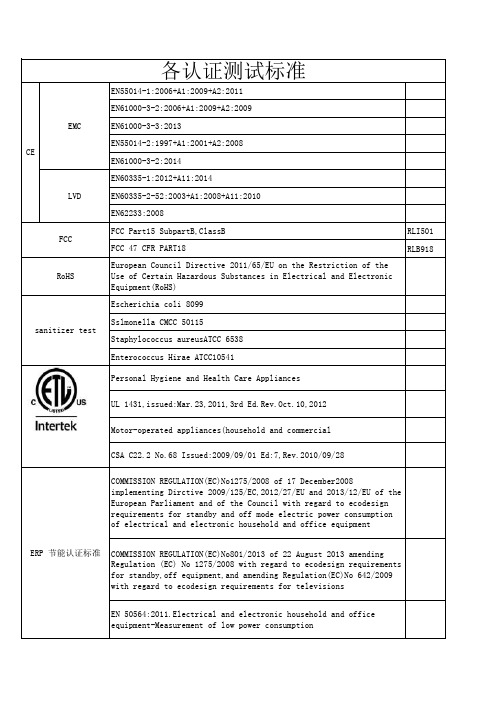
CSA C22.2 No.68 Issued:2009/09/01 Ed:7,Rev.2010/09/28
COMMISSION REGULATION(EC)No1275/2008 of 17 December2008 implementing Dirctive 2009/125/EC,2012/27/EU and 2013/12/EU of the European Parliament and of the Council with regard to ecodesign requirements for standby and off mode electric power consumption of electrical and electronic household and office equipiene and Health Care Appliances
UL 1431,issued:Mar.23,2011,3rd Ed.Rev.Oct.10,2012
Motor-operated appliances(household and commercial
欧盟废弃电子电气设 备指令
WEEE
–
2012/19/EU
RMB 4500
EN 50564:2011.Electrical and electronic household and office equipment-Measurement of low power consumption
LFGB
Sensory Test(Odour and Taste)for Materials in Contact with Foodstuffs-EC No.1935/2004 and §30 and 31 LFGB and BfR Recommendation Overall Migration Test for Plastic Materials in Contact with Foodstuffs-Commission Regulation(EU)No.10/2011 and Its Amendments Phthalate Contents for Plastic Materials in Contact with Fkkdstuffs-Commission Regulation(EU)No.10/2011 Its Amendments
15种有害物质英文
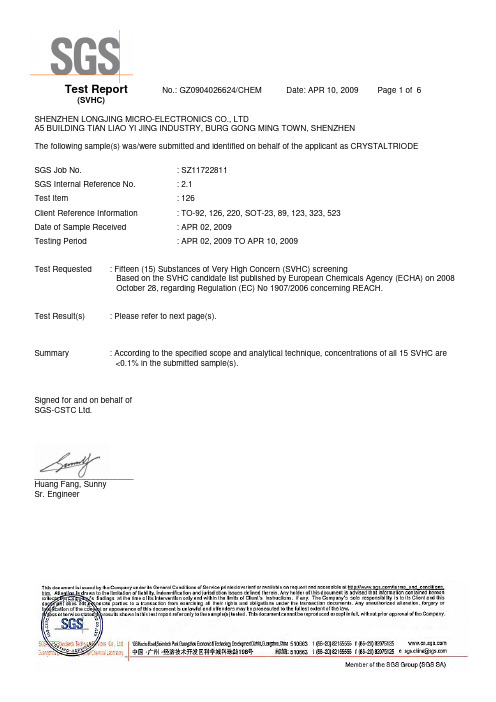
Test Report No.: GZ0904026624/CHEM Date: APR 10, 2009 Page 1 of 6 (SVHC)SHENZHEN LONGJING MICRO-ELECTRONICS CO., LTDA5 BUILDING TIAN LIAO YI JING INDUSTRY, BURG GONG MING TOWN, SHENZHENThe following sample(s) was/were submitted and identified on behalf of the applicant as CRYSTALTRIODESGS Job No. : SZ11722811SGS Internal Reference No. : 2.1Test Item : 126Client Reference Information : TO-92, 126, 220, SOT-23, 89, 123, 323, 523Date of Sample Received : APR 02, 2009Testing Period : APR 02, 2009 TO APR 10, 2009Test Requested : Fifteen (15) Substances of Very High Concern (SVHC) screeningBased on the SVHC candidate list published by European Chemicals Agency (ECHA) on 2008October 28, regarding Regulation (EC) No 1907/2006 concerning REACH.Test Result(s) : Please refer to next page(s).Summary : According to the specified scope and analytical technique, concentrations of all 15 SVHC are<0.1% in the submitted sample(s).Signed for and on behalf ofSGS-CSTC Ltd.______________________Huang Fang, SunnySr. EngineerTest Report No.: GZ0904026624/CHEM Date: APR 10, 2009 Page 2 of 6 (SVHC)Test Sample:Sample Description: “Crystaltroide”Sample as received are classified as below categories :DescriptionPolymers : (i.e. PVC, PET, ABS , Rubber)Metals : (i.e. Alloy, Stainless, Aluminium)PCBA / Composite : (i.e. PCB, IC)Non-Metal and Non-Polymers : (i.e. Textile, Paper, Leather, Wood)Glass / CeramicOthers : (i.e. Chemical Substance or Preparation, Desiccant, Carbon/Ink in Cartridge)Remark:1. Definition of classification is listed in Appendix A of this report in accordance with 67/548/EEC and Regulation (EC)No 1907/2006.Test Method:SGS In-House method- RSTS-EE-SVHC-002, Analyzed by ICP/AES, GC/MS and GC/ECD.Remarks:1. The chemical analysis of 15 SVHC is performed by means of currently available analytical techniques againstthe SVHC candidate list published by ECHA on 2008 October 28, and shall refer tohttp://echa.europa.eu/chem_data/candidate_list_table_en.asp. This list is under evaluation by ECHA and may subject to change in the future.2. In accordance with Regulation (EC) No 1907/2006, any producer or importer of articles shall notify ECHA, inaccordance with paragraph 4 of Article 7, if a substance meets the criteria in Article 57 and is identified in accordance with Article 59(1) of the Regulation, if (a) the substance is present in those articles in quantities totaling over one tonne per producer or importer per year; and (b) the substance is present in those articles above a concentration of 0.1% weight by weight (w/w).3. Article 33 of Regulation (EC) No 1907/2006 requires supplier of an article containing a substance meeting thecriteria in Article 57 and identified in accordance with Article 59(1) in a concentration above0.1% weight by weight (w/w) shall provide the recipient of the article with sufficient information, available to the supplier, to allow safe use of the article including, as a minimum, the name of that substance.4. If a SVHC is found over the reporting limit, client is suggested to identify the component which contains theSVHC and the exact concentration of the SVHC by requesting further quantitative analysis from the laboratory.Test ReportNo.: GZ0904026624/CHEMDate: APR 10, 2009Page 3 of 6(SVHC)Test Result: Substance Name CAS number EC number Concentration(%)Reporting Limit (%) ClassificationAlkanes, C10-13, chloro (Short Chain Chlorinated Paraffins) 85535-84-8 287-476-5 ND 0.01 PBT Anthracene120-12-7 204-371-1 ND 0.005 PBT 5-tert-butyl-2,4,6-trinitro-m-xylene (musk xylene) 81-15-2 201-329-4 ND 0.005 vPvB Dibutyl phthalate (DBP) 84-74-2 201-557-4 ND 0.005 Toxic to Reproduction Category 2 4,4-Diaminodiphenylmethane101-77-9 202-974-4 ND 0.005 Carcinogen Category 2 Benzyl butyl phthalate (BBP) 85-68-7 201-622-7 ND 0.005 Toxic to Reproduction Category 2 Bis (2-ethylhexylphthalate) (DEHP)117-81-7 204-211-0 ND0.005Toxic to Reproduction Category 2Hexabromocyclododecane (HBCDD) and all major diastereoisomers identified (α – HBCDD, β-HBCDD, γ-HBCDD)25637-99-4 and 3194- 55-6 (134237-51-7, 134237-50-6, 134237-52-8) 247-148-4 and 221-695-9 ND 0.005 PBT Bis(tributyltin)oxide* 56-35-9 200-268-0 ND 0.005 PBT Cobalt dichloride* 7646-79-9 231-589-4 ND 0.005 Carcinogen Category 2 Diarsenic pentaoxide* 1303-28-2 215-116-9 ND 0.005 Carcinogen Category 1 Diarsenic trioxide* 1327-53-3 215-481-4 ND 0.005 Carcinogen Category 1 Triethyl arsenate* 15606-95-8 427-700-2 ND 0.005 Carcinogen Category 1 Lead hydrogen arsenate*7784-40-9232-064-2ND0.005Carcinogen Category 1; Toxic to Reproduction Category 1 Sodium dichromate* 10588-01-9 234-190-3 ND 0.005Carcinogen Category 2; Mutagen Category 2; Toxic to Reproduction Category 2Test Report No.: GZ0904026624/CHEM Date: APR 10, 2009 Page 4 of 6 (SVHC)Remark:1*. Calculated concentration of cobalt dichloride is based on the identified cobalt by ICP-AES and the identified chloride by IC method.Calculated concentration of diarsenic pentaoxide, diarsenic trioxide, lead hydrogen arsenate and triethyl arsenate are based on the identified heavy metal result (i.e. Arsenic, Lead)Calculated concentrations of sodium dichromate are based on the identified sodium by ICP-AES and the identified chromium(VI) by spectroscopic method. The test result is reported as sodium dichromate (CAS number 10588-01-9). Please note that sodium dichromate dihydrate (CAS number 7789-12-0) is no longer classified as SVHCaccording to the latest amendment of 67/548/EEC (31th Adapation to Technical progress).Calculated concentration of bis(tributyltin)oxide TBTO is based on the identified tin by ICP- AES and confirmed by TLC.Identity of above metal substances present in the article has to be further confirmed.RL is evaluated for element (i.e. tin, cobalt, chloride, arsenic, lead, sodium, chromium (VI) respectively)2. ND = Not detected (lower than Reporting Limit)3. RL = Reporting Limit4. All RL is based on homogenous materialTest ReportNo.: GZ0904026624/CHEMDate: APR 10, 2009Page 5 of 6(SVHC)Sample photo : SGS authenticate the photo on original report onlyGZ0904026624/CHEMTest ReportNo.: GZ0904026624/CHEMDate: APR 10, 2009Page 6 of 6(SVHC)Appendix A ClassificationDefinition under 67/548/EEC and Regulation (EC) No 1907/2006Carcinogen Category 1: Substances known to be carcinogenic to man. There is sufficient evidence to establish acausal association between human exposure to a substance and the development of cancer.Carcinogen Category 2: Substances which should be regarded as if they are carcinogenic to man. There issufficient evidence to provide a strong presumption that human exposure to a substance may result in the development of cancer. Generally on the basis of:- appropriate long-term animal studies - other relevant information.Mutagen Category 1:Substances known to be mutagenic to man. There is sufficient evidence to establish a causal association between human exposure to a substance and heritable genetic damage.Mutagen Category 2:Substances which should be regarded as if they are mutagenic to man. There is sufficient evidence to provide a strong presumption that human exposure to the substance may result in the development of heritable genetic damage, generally on the basis of: - appropriate animal studies, - other relevant information.Toxic to Reproduction Category 1:Substances known to impair fertility in humans. There is sufficient evidence to establish a causal relationship between human exposure to the substance and impaired fertility. Substances known to cause developmental toxicity in humans. There is sufficientevidence to establish a causal relationship between human exposure to the substance and subsequent developmental toxic effects in the progeny.Toxic to Reproduction Category 2:Substances which should be regarded as if they impair fertility in humans. There is sufficient evidence to provide a strong presumption that human exposure to the substance may result in impaired fertility on the basis of:- clear evidence in animal studies of impaired fertility in the absence of toxic effects, or, evidence of impaired fertility occurring at around the same dose levels as other toxic effects but which is not a secondary nonspecific consequence of the other toxic effects, - other relevant information.Substances which should be regarded as if they cause developmental toxicity to humans. There is sufficient evidence to provide a strong presumption that human exposure to the substance may result in developmental toxicity, generally on the basis of:- clear results in appropriate animal studies where effects have been observed in theabsence of signs of marked maternal toxicity, or at around the same dose levels as other toxic effects but which are not a secondary non-specific consequence of the other toxic effects,- other relevant information.PBT & vPvB:Substances which are persistent, bioaccumulative and toxic (PBT) or very persistent and very bioaccumulative (vPvB) pose a particular challenge to the chemicals safetymanagement. For these substances a “safe” concentration in the environment cannot be established with sufficient reliability.*** End of Report ***。
SVHC物质清单(英文版)
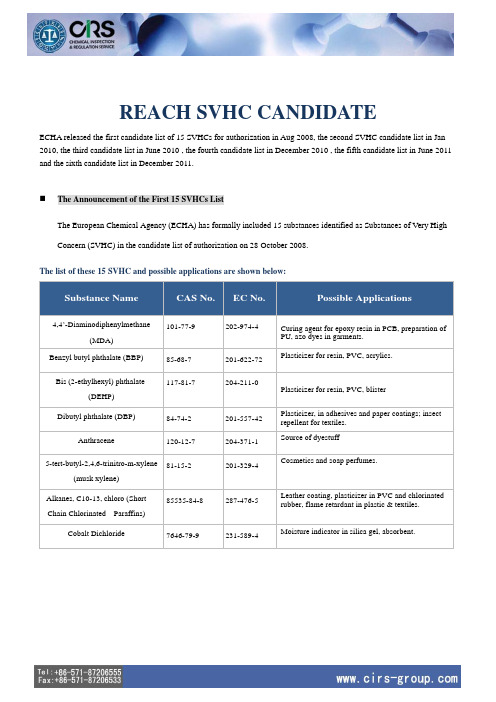
REACH SVHC CANDIDATEECHA released the first candidate list of 15 SVHCs for authorization in Aug 2008, the second SVHC candidate list in Jan 2010, the third candidate list in June 2010 , the fourth candidate list in December 2010 , the fifth candidate list in June 2011 and the sixth candidate list in December 2011.The Announcement of the First 15 SVHCs ListThe European Chemical Agency (ECHA) has formally included 15 substances identified as Substances of Very High Concern (SVHC) in the candidate list of authorization on 28 October 2008.The list of these 15 SVHC and possible applications are shown below:The Announcement of the Second 15 SVHCs ListThe European Chemical Agency (ECHA) officially published the second SVHC candidate list which includes a total of 29 substances on January 13th, 2010.ECHA added the substance “Acrylamide” back to the candidate list on March 30th.The list of these 15 SVHC and possible applications are shown below:The Announcement of the Third 8 SVHCs ListThe European Chemicals Agency (ECHA) has added 8 extra chemical Substances of Very High Concern (SVHC) to the Candidate List on 18th June 2010 on top of the 15 SVHC that had been regulated in October 2008, and 15 SVHC in January 2010.The list of these 8 SVHC and possible applications are shown below:The Announcement of the Fourth 8 SVHCs ListThe ECHA has added eight more chemical Substances of Very High Concern (SVHC) to the Candidate List on 15th December 2010.The list of these 8 SVHC and possible applications are shown below:The Announcement of the Fifth 7 SVHCs ListThe list of these 7 SVHC and possible applications are shown below:The list of these 20 SVHC and possible applications are shown below:⏹According to REACH regulation, all EU manufacturers or importers of the 73 SVHCs should fulfill eitherone of the following regulatory obligations:1.should supply Safety Data Sheet (SDS/MSDS) to their downstream users when the SVHC concerned issold as a substance on itself; or2.should supply SDS/MSDS to their downstream users when the SVHC concerned is produced orimported at or above 0.1% w/w in a mixture or preparation; or3.should supply the product recipient or in request of the product consumers, with availablesufficientinformation, free of charge, which covers at least the name of the substance, within 45 days on receiving the request, if the SVHC is above 0.1% w/w threshold in an article.⏹All EU manufacturers or importers must submit a notification for SVHCs placed on EU market before June1, 2011 to European Chemicals Agency (ECHA), if the substance is produced or imported above the quantity of 1 tonne per year and its concentration percentage in the article above the threshold of 0.1% w/w.。
欧盟环保要求概述
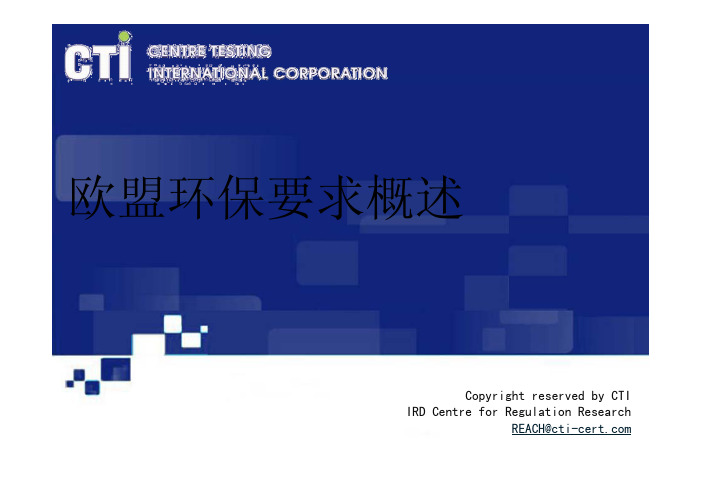
Anthracene oil Anthracene oil, anthracene paste, distn. Lights v Anthracene oil, anthracene paste, anthracene fraction Anthracene oil, anthracene-low Anthracene oil, anthracene paste Diisobutyl phthalate 2,4-Dinitrotoluene coal tar pitch, high temperature tris(2-chloroethyl)phosphate Aluminosilicate, Refratory Ceramic Fibres Zirconia Aluminosilicate, Refratory Ceramic Fibres Lead sulfochromate yellow (C.I. Pigment Yellow 34) Lead chromate molybdate sulfate red (C.I. Pigment Red 104) Lead chromate Acrylamide
判断某物品属于复杂物品还是一套物品关键在于供货状态: 如供货的物品由接收方组装使用,应视作一套物品,SVHC含量应针对各个部件 分别计算;如供货给接收方的是已经组装好的物品,应视作一个复杂物品,SVHC 含量就应整体计算。
某些国家赞同“一旦成为物品,就永远是物品”的观点,包含丹麦、奥地利、比 利时、德国、法国、瑞典及挪威。它们认为某产品只要满足了物品的定义就 应单独计算SVHC的含量.
针对产品中含有的授权清单 物质(附件14)进行管控 授权
Authorisation For the substances which are very high concerned in the Annex XIV in the product
最新 2019年9月3日 REACH 205项 SVHC 清单 高度关注物质清单 最新增加4项 第22次增加

2019年REACH197项SVHC清单第二十二批SVHC候选物质2019年9月3日,欧洲化学品管理局(ECHA)公布对Reach法规4种潜在的高度关注物质(SVHCs)展开公众评议。
公众咨询将于2019年10月18日结束,在此期间各利益相关方均可向ECHA提交评议意见。
通过评议的物质将作为第22批物质列入SVHC候选清单。
如果评议通过,SVHC或从201项增加至205项。
如果投放欧盟市场的“物品”类产品中含有浓度>0.1%的任意一种SVHC候选物质,欧盟生产商或进口商应履行REACH法规规定的告知、通报等义务:在收到消费者咨询时,需在45天之内将相关信息提供给消费者;含量>0.1%且该物质进入欧盟的总量>1吨/年时,欧盟生产商或进口商必须先向ECHA进行通报,产品方可在欧盟市场销售。
“物质或混合物”类产品(如涂料、油墨等)若含有SVHC候选物质,则生产厂商应向下游使用者提供安全技术说明书(SDS)。
第二十一批SVHC候选物质2019年7月16日,欧盟化学品管理局(ECHA)将新一批共4项物质加入SVHC 候选清单,至此SVHC候选清单已增加至201项物质。
新增4项SVHC候选物质信息如下表:第二十一批SVHC候选物质如果投放欧盟市场的“物品”类产品中含有浓度>0.1%的任意一种SVHC候选物质,欧盟生产商或进口商应履行Reach法规规定的告知、通报等义务:●在收到消费者咨询时,需在45天之内将相关信息提供给消费者;●含量>0.1%且该物质进入欧盟的总量>1吨/年时,欧盟生产商或进口商必须先向ECHA进行通报,产品方可在欧盟市场销售。
●“物质或混合物”类产品(如涂料、油墨等)若含有SVHC候选物质,则生产厂商应向下游使用者提供安全技术说明书(SDS)。
(15 January 2019生效)Six new substances added to the Candidate ListECHA/PR/19/01The Candidate List of substances of very high concern (SVHCs) for authorisation now contains 197 substances.Helsinki, 15 January 2019–ECHA has added five new substances to the Candidate List due to the carcinogenic, toxic to reproduction, persistent, bioaccumulative and toxic (PBT) and very persistent and very bioaccumulative (vPvB) properties of the substances. The decision to include the four polycyclic aromatic hydrocarbons (PAHs) was taken with the involvement of the Member State Committee (MSC). The four PAH cases were referred to the MSC in order to address new hazard information submitted during the public consultation.One further substance has also been added to the list having been identified as an SVHC by the European Commission due to its endocrine-disrupting properties. The Commission’s decision follows the referral of the MSC opinion on this SVHC proposal in 2016.Substances included in the Candidate List for authorisation on 15 January 2019 and their SVHC properties:Furthermore, one dossier submitter (the German competent authority) decided to withdraw its proposal to identify undecafluorohexanoic acid and its ammonium salt (PFHxA) as an SVHC during the MSC agreement-seeking process.BackgroundThe Candidate List is a list of substances that may have serious effects on human health or the environment. Substances on the Candidate List are also known as substances of very high concern and are candidates for eventual inclusion in the Authorisation List. Once they are on the Authorisation List, industry will need to apply for permission to continue using the substance after the sunset date.Companies may have legal obligations resulting from the inclusion of the substance in the Candidate List. These obligations may apply to the listed substance on its own, in mixtures or in articles. In particular, any supplier of articles containing a Candidate List substance above a concentration of 0.1 % (weight by weight) has communication obligations towards customers down the supply chain and consumers. In addition, importers and producers of articles containing the substance have six months from the date of its inclusion in the Candidate List (15 January 2019) to notify ECHA. Information on these obligations and related tools are available on ECHA’s website.2018年6月27日新增加10种2018年6月27日,欧洲化学品管理局(ECHA)正式公布Reach法规第19批SVHC候选物质,将10种新的物质加入到高度关注物质(SVHCs)候选物质清单。
- 1、下载文档前请自行甄别文档内容的完整性,平台不提供额外的编辑、内容补充、找答案等附加服务。
- 2、"仅部分预览"的文档,不可在线预览部分如存在完整性等问题,可反馈申请退款(可完整预览的文档不适用该条件!)。
- 3、如文档侵犯您的权益,请联系客服反馈,我们会尽快为您处理(人工客服工作时间:9:00-18:30)。
Diisobutyl phthalate 邻苯二甲酸二异丁酯 2-Methoxyethanol 甲氧基乙醇 2-Ethoxyethyl acetate 2-乙氧基醋酸 Lead diazide, Lead azide 迭氮化铅 N,N-dimethylacetamide N,N-二乙酰胺 Lead dipicrate 苦味酸铅
1,2-Benzenedicarboxylic acid, di-C7-11-branched and linear alkyl esters 1,2-苯二酸-二(C7-11支链与直链)烷基(醇)酯 Dibutyl phthalate (DBP) 邻苯二甲酸二丁酯 1-Methyl-2-pyrrolidone 1--2-吡咯烷酮 Tris(2-chloroethyl)phosphate 磷酸三(2-氯乙基)酯
Diboron trioxide 三氧化二硼 Tetraboron disodium heptaoxide, hydrate 水合硼酸钠 1,2-bis(2-methoxyethoxy)ethane (TEGDME; triglyme) 三甘醇二甲醚
Boric acid 硼酸 Lead(II) bis(methanesulfonate) 甲基磺酸铅
Dichromium tris(chromate) 铬酸铬 2-Methoxyaniline; o-Anisidine 邻甲氧基苯胺2
Pentazinc chromate octahydroxide 锌黄 Arsenic acid 砷酸
Potassium hydroxyoctaoxodizincatedichromate 氢氧化铬酸锌钾
Alkanes, C10-13, chloro (Short Chain Chlorinated Paraffins) 短链氯化石蜡 Bis(tributyltin)oxide (TBTO) 三丁基氧化锡 Anthracene 蒽
Hexabromocyclododecane (HBCDD) and all major diastereoisomers identified: Alpha-hexabromocyclododecane Beta-hexabromocyclododecane Gammahexabromocyclododecane 六溴环十二烷及其非对映异构体(α–HBCDD, β-HBCDD, γ- HBCDD) 1,3,5-tris[(2S and 2R)-2,3-epoxypropyl]-1,3,5-triazine-2,4,6-(1H,3H,5H)-trione (β-TGIC) 异氰脲酸Β-三缩水甘油酯
1,3,5-Tris(oxiran-2-ylmethyl)-1,3,5-triazinane-2,4,6-trione (TGIC) 异氰尿酸三缩水甘油酯 4-(1,1,3,3-tetramethylbutyl)phenol 对特辛基苯酚
Anthracene oil, anthracene paste, anthracene fraction 蒽油,蒽糊,蒽馏分 Anthracene oil, anthracene-low 蒽油,低含蒽量 Anthracene oil, anthracene paste 蒽油,蒽糊
Bis (2-ethylhexyl)phthalate (DEHP) 塑化剂
1,2-Benzenedicarboxylic acid, di-C6-8-branched alkyl esters, C7-rich 1,2-苯二酸-二(C6-8支链)烷基酯(富C7)
2-Ethoxyethanol . 2-乙氧基乙醇
[4-[4,4'-bis(dimethylamino) benzhydrylidene]cyclohexa-2,5-dien-1-ylidene]dimethylammonium chloride (C.I. Basic Violet 3) [with0.1% of Michler's ketone (EC No. 202-027-5) or Michler's base (EC No. 202-959-2)]结晶紫(含有0.1%的米氏酮或米氏碱)
N,N,N',N'-tetramethyl-4,4'-methylenedianiline N,N,N'N'-四甲基-4,4'-二氨基二苯甲烷
Diarsenic trioxide 三氧化二砷
2,4-Dinitrotoluene . 2,4-二硝基甲苯
Triethyl arsenate 三乙基砷酸酯
Trilead diarsenate 砷酸铅 Cobalt(II) carbonate 碳酸钴 Cobalt(II) dinitrate 乙酸钴 1,2,3-Trichloropropane (1,2,3-TCP)1,2,3-三氯丙烷 Cobalt dichloride 氯化钴 Potassium chromate 铬酸钾
4,4'-bis(dimethylamino)benzophenone (Michler's ketone) 米氏酮, 4,4'-四甲基二氨二苯酮 Hydrazine 肼
Trichloroethylene 三氯乙烯
Phenolphthalein .酚酞
1,2-dichloroethane 1,2-二氯乙烷 Calcium arsenate 砷酸钙
Anthracene oil, anthracene paste,distn. Lights 蒽油,蒽糊,轻油
Anthracene oil 蒽油 Pitch, coal tar, high temp. 高温煤沥青 Sodium dichromate . 重铬酸钠 Potassium dichromate 重铬酸钾 Ammonium dichromate 重铬酸铵 Sodium chromate 铬酸钠
Diarsenic pentaoxide 五氧化二砷
Strontium chromate 铬酸锶
4,4'-bis(dimethylamino)-4''-(methylamino)trityl alcohol [with 0.1% of Michler's ketone (EC No. 202-027-5) or Michler's base (EC No. 202-959-2)] ol 二[(二甲氨基)苯基]-4-甲氨基苯甲醇(含有0.1%的米氏酮或米氏碱)
Acrylamide
丙烯酰胺
Chromium trioxide . 三氧化铬
a,a Bis[4-(dimethylamino)phenyl]-4 (phenylamino)naphthalene-1-methanol (C.I. Solvent Blue 4) [with 0.1% of Michler's ketone (EC No. 202-027-5) or Michler's base (EC No. 202-959-2) 溶剂蓝 4 (含有0.1%的米氏酮或米氏碱)
Aluminosilicate Refractory Ceramic Fibres are fibres covered by index number 650-017-00-8 in Annex VI, part 3, table 3.1 of Regulation (EC) No 1272/2008 of the European Parliament and of the Council of 16 December 2008 on classification, labelling and packaging of substances and mixtures, and fulfil the three following conditions: a) oxides of aluminium and silicon are the main components present (in the fibres) within variable concentration ranges b) fibres have a length weighted geometric mean diameter less two standard geometric errors of 6 or less micrometres (µm) c) alkaline oxide and alkali earth oxide (Na2O+K2O+CaO+MgO+BaO) content less or equal to 18% by weight 硅酸铝耐火陶瓷纤维
Formamide 甲酰胺 Lead styphnate .收敛酸铅 1,2-dimethoxyethane; ethylene glycol dimethyl ether (EGDME) 二甲基丙烯酸乙二醇酯 Bis(2-methoxyethyl) phthalate 邻苯二甲酸二甲氧乙酯 Disodium tetraborate, anhydrous 四硼酸钠,无水 Bis(2-methoxyethyl) ether (diglyme) 醚 (二乙二肟)
[4-[[4-anilino-1-naphthyl][4-(dimethylamino)phenyl]methylene]cyclohexa-2,5-dien-1-ylidene] dimethylammonium chloride (C.I. Basic Blue 26) with 0.1% of Michler's ketone (EC No. 202-027-5) or Michler's base (EC No. 202-959-2)]碱性蓝26(含有0.1%的米氏酮或米氏碱) 4,4'- Diaminodiphenylmethane (MDA) 4,4二氨基二苯基甲烷
